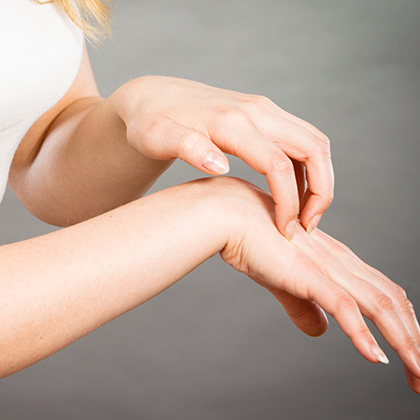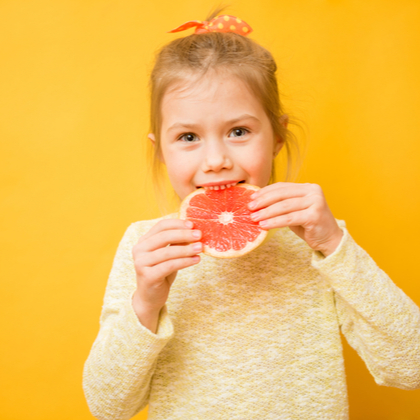Most children - particularly those under the age of 10 - catch chickenpox (i) thanks to the fact that the virus that causes it is highly infectious. This explains why more than 90 percent of adults are immune to chickenpox, because if you get it once, you become immune to the virus (i).
But after a child has chickenpox, the virus - called varicella-zoster - travels up a nerve root near the spine and stays there, lying dormant. And in later life it can reactivate, causing a condition called shingles. Shingles is quite common, with one in four people having at least one episode during their life (ii).
Itchy rash
Both chickenpox and shingles cause a rash that turn into itchy blisters. With chickenpox, the rash can cover a child's body - though some children have a mild attack with just a few spots. Other symptoms are similar to those of flu, such as a high temperature, aches and pains and nausea. If you catch chickenpox as an adult, these flu-like symptoms can be worse than if you'd had it as a child (in fact, the older you are getting chickenpox, the worse your symptoms tend to be).
The shingles rash, on the other hand, most commonly affects one side of the body, usually the upper body - though you can also get it on your head and neck, and even your eyes. But while the chickenpox rash is just very itchy, the shingles rash also causes a dull or burning pain - which can be severe in some people - and you may experience tingling and numbness too. Like chickenpox, shingles can cause flu-like symptoms such as headache and a high temperature. Itchy rashes from both conditions are more likely to be worse if you have an existing skin condition such as eczema.
How long do they last?
The chickenpox rash gets very itchy very quickly (after about 12 hours), then the blisters start to dry out and form scabs after a day or two. For the first three to five days, new spots may appear, so a child with chickenpox will typically have some spots crusting over and some filled with fluid. The scabs should start falling off after one or two weeks, when the rash should gradually disappear. Some marks may be left by the scabs, but in younger children the scabs don't leave behind any scarring (teenagers and adults, however, may be left with some chickenpox scars). Discover more on how to manage scars from chickenpox.
Shingles, on the other hand, can last longer, with a typical episode dying down after two to four weeks. During the first week new blisters may keep appearing, but after a few days they dry out and crust over.
Some people can develop a condition called post-herpetic neuralgia (PHN) after having shingles, particularly those who are elderly or have a weakened immune system (PHN is thought to affect up to one in five people over the age of 50 who've had shingles (iii)). The most common complication of shingles, PHN can cause severe nerve pain and itching long after the rash has disappeared, lasting for months or even years (in some cases, says the NHS, PHN can be permanent (iii)).
Chickenpox rarely causes serious complications, but a very small number of children go on to develop encephalitis (infection of the brain) or meningitis. Babies less than four weeks old are most at risk of developing chickenpox complications, as are pregnant women and those with a weakened immune system (iv) .
Chickenpox treatments
While having chickenpox can make you feel unwell and irritable, the virus usually clears up without any treatment. You can, however, take paracetamol - an over-the-counter painkiller - if you have a high temperature or if you're in pain. If you're caring for a child with chickenpox, make sure to give them the correct dose of paracetamol for their age (always read the dosage instructions).
You should, however, avoid treating the symptoms of chickenpox with ibuprofen, which is also an over-the-counter painkiller. That's because there's a small risk of ibuprofen and other non-steroidal anti-inflammatory drugs (NSAIDs) causing skin reactions with chickenpox (v).
If you're having problems sleeping because the rash is making you itch, you may be able to take an over-the-counter antihistamine in tablet or liquid form that acts as a mild sedative (these aren't suitable for children under a year old). Applying calamine lotion or a cooling gel may also help soothe itching skin.
Pregnancy warning
If you catch chickenpox while you're pregnant, the virus can cause severe symptoms and may also cause complications for your unborn baby. Only three in every 1,000 women catch chickenpox during pregnancy in the UK, says the NHS (vi).
But if you do catch the virus during pregnancy, you may have to take an antiviral medicine or have immunoglobulin treatment - which is given by injection - to stop your symptoms getting worse (see your GP immediately if you're pregnant and think you may have chickenpox).
Some adults with chickenpox may also need antiviral medicine to prevent their symptoms becoming severe (these medicines, however, are usually only effective if taken early on in the course of the infection).
Stop the virus spreading
Meanwhile if you or your child has chickenpox, it's important to stay away from women who may be pregnant as well as newborn babies and anyone with a weakened immune system. Public Health England recommends that children with chickenpox are kept home from school for five days, though their blisters must have fully crusted over before they return (this is when the virus is no longer infectious) (vii).
It's also a good idea to keep objects and surfaces free from the virus by cleaning them with a sterilising solution to stop the virus spreading to other members of your household. Also wash any bedding and clothes that may be infected with the virus.
Should you see your GP?
Most cases of chickenpox clear up by themselves so you shouldn't usually have to see a doctor. But there are a few instances when you should see your GP straight away, including the following:
-
If the skin around the blisters becomes red and painful.
-
If you develop breathing difficulties or chest pain.
-
If you become drowsy or feel very weak.
-
If your rash bruises or bleeds into the skin.
-
If you have pain or a headache that gets worse despite taking paracetamol.
Treatments for shingles
Like chickenpox, there's no cure for shingles. But if you think you have shingles, you should see your GP straight away, as you may need a prescription painkiller such as codeine. Some people, however, may only need to take paracetamol, which is available without a prescription.
Some people with shingles - usually people aged 50 and older and those with a weakened immune system - may also be prescribed a course of antiviral tablets. And the reason it's important to your doctor as soon as possible is that antiviral medicines - which can make your symptoms milder as well as reduce how long they last - are most effective if you take them within 72 hours of the rash appearing.
If you have severe pain with the shingles virus, your GP may suggest you take a type of antidepressant medicine or an epilepsy medication, both of which are also used to treat nerve pain. Medical moisturisers called emollients - which you can buy over the counter - may also help if your rash is itchy, or you could try applying calamine lotion to the affected area.
Is it contagious?
While you can't get shingles from someone with the varicella-zoster virus, you can catch chickenpox from them if you haven't already had it. This explains why it's important to avoid contact with other people who may not have had chickenpox - especially pregnant women and those with an immune system problem - until you're no longer contagious (ie when your blister have dried up). If you can cover up your blisters with clothing, your risk of infecting others is small.
Should you get the jab?
Currently, if you're aged between 70 and 78, you're eligible for a vaccine to prevent shingles on the NHS (viii). This is a single injection (unlike the flu jab, which you need to have every year), and can help prevent the reactivation of the shingles virus or make your symptoms milder and last for a shorter length of time if you do get it.
According to the NHS, shingles is fatal for around one person in every 1,000 aged 70 and older (iii) - rare complications include pneumonia, hepatitis, encephalitis and meningitis - while for many others it can be very painful and uncomfortable. But even if you've already had shingles, you can still get the vaccine, as some people get the virus more than once. You don't have to do anything, as your GP will invite you to have the vaccine when you're eligible.
Self-care for chickenpox and shingles
If you or someone you're caring for has chickenpox or shingles, there are a few things you can do to make yourself or them more comfortable:
Six chickenpox dos and don'ts:
-
Do drink lots of fluids, especially water, to prevent dehydration.
-
Don't wrap yourself up if your room has a normal temperature - instead stay cool and wear loose-fitting clothes, preferably made of cotton.
-
Do apply a cooling gel or lotion - such as calamine lotion - to soothe your skin
-
Don't try to cool a child's skin with a cold sponge - this can actually make their temperature worse.
-
Do keep fingernails clean and short to prevent scratching and possible scarring.
-
Don't use a fan directly on a child to keep them cool - but do use a fan on the other side of the room to keep the air circulating or open a window.
Six shingles dos and don'ts:
-
Do keep your rash clean and dry to prevent it becoming infected.
-
Do use non-sticky dressings to cover your blisters to prevent the virus spreading to others (this may also reduce pain caused when your rash comes into contact with your clothes).
-
Don't wear clothing that makes you too hot - choose something loose and cool (tight clothing may irritate your rash and make it more inflamed).
-
Do use a cool compress or take a cool bath to soothe your skin, or apply calamine lotion to relieve itching.
-
Don't share things like towels and flannels with anyone else while you have a rash (wash anything that comes into contact with your skin on the hottest possible temperature setting on your washing machine).
Natural relief for chickenpox and shingles
If your skin is itching, aloe vera gel may be an ideal alternative to calamine lotion. Another way to soothe your skin naturally is to take an oat bath. Put a handful of oats in a muslin bag (or take a square of muslin or similar material, place a handful of oats in the middle and tie the corners together) and either drop the bag/cloth in your bath water or secure it beneath the tap, so that the water runs through it (oats are thought to contain anti-inflammatory compounds that ease skin irritation).
There are also a few nutritional supplements you could try, including the following:
High-strength multivitamin and mineral
If you have shingles or post-herpetic neuralgia, a high-potency multivitamin and mineral supplement may help protect against cell damage. Look for a supplement with all the key ingredients, including vitamins C, E and selenium for antioxidant support.
Lysine
You may also like to support your skin by taking a lysine supplement. Lysine (also called L-lysine) is one of the eight essential amino acids, and is thought to play an important role in the immune system. One study, for instance, suggests a combined supplement of lysine and zinc may help reduce infections in elderly people with immune system dysfunction (ix). Lysine is also important for the body's production of collagen, a protein that's essential for healthy skin. Some natural health practitioners also believe taking a lysine supplement may reduce the pain of shingles as well as speed up recovery.
B complex
A good-quality vitamin B complex supplement that includes vitamin B12 may help support the production of myelin, which is essential for the formation of the myelin sheath (a protective fatty layer that covers the spinal, cranial and peripheral nerves). Vitamin B12 deficiency is known to cause myelin sheath damage, which may lead to neurological problems (x).
The virus that causes shingles is thought to lay dormant in nerve pathways as well as in myelin sheaths and cells. Some natural health practitioners believe that keeping the myelin sheath healthy may even make the reactivation of the virus - which causes the symptoms of shingles - less likely.
PEA
Natural health practitioners also report that a supplement called PEA – short for palmitoylethanolamide – may help relieve the pain of shingles. PEA is a type of fatty acid made naturally by the body and found in all cells, tissues and fluids including the brain, as well as in foods including soya beans, peanuts, eggs, flaxseed and milk. Described by scientists as an endocannbinoid-like chemical that belongs to a family of fatty acid compounds called amides (xi), PEA is often mentioned as an alternative to CBD, since both substances are thought to have similar properties including the ability to reduce pain and inflammation. However, researchers suggest PEA is safer than CBD, since it has been studied more extensively and has a more robust safety profile (xii) with no known side effects (xi).
There is some evidence to suggest PEA may be helpful in relieving the pain of shingles. One study, published in the journal Pain Medicine, found PEA was effective and safe in the management of chronic pain in different conditions, one of which was shingles (xiii). A case report published in the journal Nutrition and Health also found it provided effective pain relief within 48 hours in a patient suffering with neuropathic pain caused by shingles (xiv).
If you’d like to learn more about a range of other common health conditions, feel free to visit our health library.
References:
-
Available online: https://www.nhsinform.scot/illnesses-and-conditions/infections-and-poisoning/chickenpox
-
Available online: https://patient.info/skin-conditions/shingles-herpes-zoster-leaflet - nav-3
-
Available online: https://www.nhsinform.scot/illnesses-and-conditions/infections-and-poisoning/shingles#complications-of-shingles
-
Available online: https://www.nhsinform.scot/illnesses-and-conditions/infections-and-poisoning/chickenpox#complications-of-chickenpox
-
Mikaeloff. Y, Kezouh. A, Suissa. S. Nonsteroidal antiinflammatory drug use and the risk of severe skin and soft tissue complications in patients with varicella or zoster disease. Br J Clin Pharmacol. 2008 Feb;65(2):203-9.Available online: https://www.ncbi.nlm.nih.gov/pubmed/18251759
-
Available online: https://www.nhs.uk/common-health-questions/pregnancy/what-are-the-risks-of-chickenpox-during-pregnancy/
-
Available online: https://www.gov.uk/government/publications/health-protection-in-schools-and-other-childcare-facilities/chapter-9-managing-specific-infectious-diseases
-
Available online: https://www.nhs.uk/conditions/vaccinations/who-can-have-the-shingles-vaccine/
-
Sugeng. MW, Adriani. M, Wirjatmadi. B. The Effect of Zinc and Lysine Supplementation on Infection Rate and CD4 Count In Elderly. Biochemistry & Physiology: Open Access. 2015 June;110:359-362.Available online: https://www.omicsonline.org/open-access/the-effect-of-zinc-and-lysine-supplementation-on-infection-rate-and-cd4-count-in-elderly-2168-9652-S5-002.php?aid=58825
-
Available online: https://www.foundationforpn.org/what-is-peripheral-neuropathy/causes/vitamin-nutrition-deficiency/
-
Clayton P. et al., Palmitoylethanolamide: A Natural Compound for Health Management. Int J Mol Sci. 2021 May ;22(10): 5305. Available online: https://www.ncbi.nlm.nih.gov/pmc/articles/PMC8157570/
-
Clayton P. et al., Palmitoylethanolamide: A Potential Alternative to Cannabidiol. J Diet Suppl. 2021 Nov 28 ;1-26. Available online: https://www.tandfonline.com/doi/full/10.1080/19390211.2021.2005733
-
Gatti A. et al., Palimitoylethanolamide in the Treatment of Chronic Pain Caused by Different Etiopathogenesis. Pain Med. 2021 Sep ;13(9):1121-30. Available online: https://academic.oup.com/painmedicine/article/13/9/1121/1864240
-
Kamper D., Palmitoylethanolamide (PEA) in the treatment of neuropathic pain: a case study. Nutr Health. 2022 Jun ;28(2):265-269. Available online: https://journals.sagepub.com/doi/10.1177/02601060211019669
Related Posts
Disclaimer: The information presented by Nature's Best is for informational purposes only. It is based on scientific studies (human, animal, or in vitro), clinical experience, or traditional usage as cited in each article. The results reported may not necessarily occur in all individuals. Self-treatment is not recommended for life-threatening conditions that require medical treatment under a doctor's care. For many of the conditions discussed, treatment with prescription or over the counter medication is also available. Consult your doctor, practitioner, and/or pharmacist for any health problem and before using any supplements or before making any changes in prescribed medications.

Christine
Christine Morgan has been a freelance health and wellbeing journalist for almost 20 years, having written for numerous publications including the Daily Mirror, S Magazine, Top Sante, Healthy, Woman & Home, Zest, Allergy, Healthy Times and Pregnancy & Birth; she has also edited several titles such as Women’ Health, Shine’s Real Health & Beauty and All About Health.
View More



